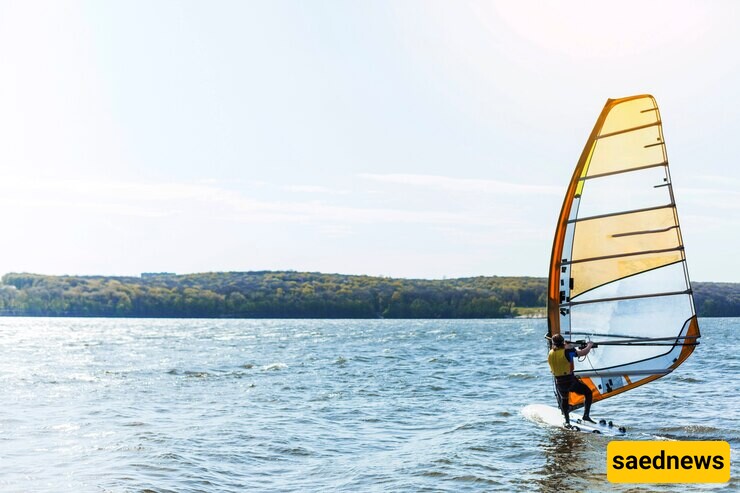SAEDNEWS: Windsurfing, or sailboarding windsurfing or sailboarding), is a sport combining surfing and sailing, performed using a windsurfing board.


In this sport, a special board with a length of 2 to 4 meters is used, and the athlete moves by harnessing the power of the wind on a sail mounted on this board. Unlike surfing, windsurfing does not require large waves. The equipment installed on the board and mast are easily adjustable, allowing the athlete a high degree of freedom while moving. The sail area ranges from about 3 square meters to 12 square meters, depending on various conditions and the skill of the athlete.
Windsurfing or sailboarding S. Newman Darby, with the wind origin, invented the sport in 1964 on the Susquehanna River in Pennsylvania, USA, while pioneering the "Darby sailing board." However, due to limited financial resources and inadequate legal advice, he did not patent the invention. His primary focus was on selling plans so that any school-age child could build one for less than $50. Rather than creating personal wealth, his focus was on introducing young people to sailing, even in very shallow waters. In 1964, Darby began selling his sailing boards. Darby’s promotional article was published in the August 1965 edition of Science magazine. Windsurfing provides experiences outside the scope of other sailing designs. Athletes can perform jumps, reverse loops, spins, and other "free" maneuvers that cannot be achieved with any other type of sailing boat. Windsurfers were the first to ride the largest waves in the world, such as those at Jaws on Maui Island, and with very few exceptions, it was not until the rise of wave surfing that waves of such magnitude were accessible to traditional surfers. Professional windsurfers often ride the same waves as surfers on large waves.
As a beginner, you should know that surfing is one of the most complex sports in the world, and achieving your first success will present many challenges. When you fail to catch a wave, you may feel frustrated, but this will happen repeatedly on your journey to success. Even the best surfers sometimes fail to catch big, unexpected waves, but they always remember one thing: they don’t give up on their daily efforts! You may get injured many times during surfing, but eventually, you will have a smile on your face that never fades. Just stay positive, be patient, and train hard until you ride a wave, experiencing a feeling that will never be forgotten.
To transition from a beginner to an intermediate surfer, you need to know the correct posture for your body on the surfboard. The first tip is to place your feet close together—many beginner surfers place their feet too far apart. Just look at professional surfers and follow their lead. Another mistake is the posture on the board: don't lie flat like a pancake on the board! Stretch your body and head, staying powerful and flexible in the water.
Waves have their own rules and are naturally powerful and wild. Always remember that surfing is one of the most dangerous sports because, most of the time, there are currents in the water moving in different directions, which you likely can't see from the shore. Sometimes these currents are powerful, and in the worst case, they may make it difficult to find your way back to the shore. Make sure your arms are strong enough to paddle back to the shore. One mistake beginners often make is overestimating themselves. As mentioned, surfing takes time, and the best thing you can do as a beginner is to find a surfing instructor.
Once you reach a designated area in the water, you must wait for the waves and always face the horizon. Always remember: your playing field is constantly changing. Waves are never controllable, and all you can do is learn how to read them. Know where to wait for waves and when the best time to head toward the wave is. Tides, winds, and other factors influence the waves, and sand, rocks, and reefs cause variations in the different wave levels.
For surfing, the right equipment is very important. Different types of waves require different boards: calm waves, steep waves, and each wave type has its own ideal board. As a beginner, it’s better to rent a wide board because it is easier to paddle and catch waves on larger boards. On these boards, you will have better balance, and foam boards are more stable in the water, making them more suitable for beginners. The material of these boards is also very important because fiberglass boards are hard and brittle, making them difficult for beginners to handle. Smaller boards are harder to maneuver than larger ones because they require more effort. Another tip is that when walking on the board, make sure to keep the leash in your hand and never let go of it.
The worst thing you can do while surfing is to take someone else’s wave! When you start surfing, make sure to learn and respect the rules. Every wave is meant for one person, and that is the surfer closest to the peak of the wave. Before heading toward a wave, look around and if the conditions are not favorable, don’t go into the wave.

